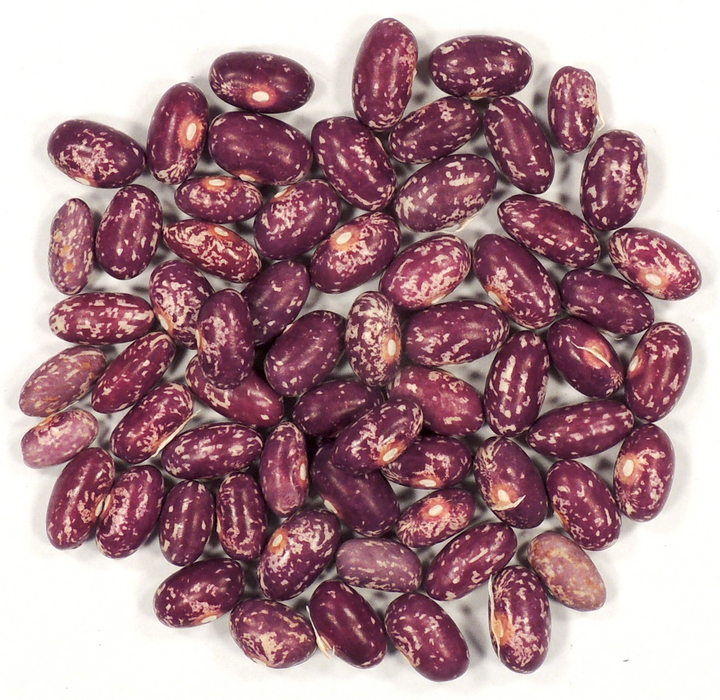Profile

The runner bean is also known as fire bean (Phaseolus coccineus L.). Its color varies from black-purple to beige-brown.
Originally native to Central and South America, the runner bean is very sensitive to cold and frost. Germination and growth require a certain temperature and humidity. Due to the warmer climate, it now also feels at home here - especially in Styria. In 2016, the Styrian runner bean was recognized by the EU as a protected designation of origin. This is only possible for products where there is a direct link between the food and the origin. The Styrian runner bean must therefore be harvested and processed in Styria.
Usage
The preparation forms of the runner bean are varied: cooked as a side dish, in soups, salads or in vegetable stew. A well-known specialty is the Styrian runner bean salad. Before consumption, the beans must be cooked to render the toxic phasin harmless. After soaking for several hours (in a ratio of about 1:3), for example overnight, the subsequent cooking time is about 1 to 2 hours. The addition of spices mitigates the bloating effects of the legumes. Cooked runner beans are a good source of protein and rich in vitamin C among legumes.
Botany
The runner bean belongs to the legume family. It is an annual and grows with its twining stem 2 to 7 m high. The leaves are long-stalked and three-toothed, and the entire margins are usually broad. The erect flower clusters are longer than their bracts and twelve to 20-flowered. The shuttle beak of the rich red or white butterfly flowers is coiled only one to one and a half times and the flowers are cross-pollinated. The five to eleven mostly purple seeds, speckled with black, are in 12-35 cm long 2-3 cm wide straight or only slightly curved rough pods.
Agricultural aspects
In 2023, beetle beans were grown on 761 hectares in Austria. The main producer is Styria with 565 hectares, with most of the beetle beans coming from south-east Styria.
They are sown between the end of April and mid-May at a soil temperature of around 8 to 10 degrees Celsius. Soil temperatures of 10-15 °C are required for uniform germination. Temperatures that are too low during germination and juvenile development result in reduced, compact growth and lower yields.
Beans are sown at a soil depth of 2-4 cm as single seeds 6 to 8 cm apart in a row or as a cluster seed with five to seven seeds per planting site. Germination takes place underground.
The seedlings germinate after approx. two weeks and are relatively undemanding during growth; additional watering is only necessary in very dry conditions. As far as fertilisation is concerned, the plants should not be fertilised purely with nitrogen, as beans are a low-yielding vegetable, but they do require additional potash. Beetle beans are not particularly demanding in terms of soil and nutrient supply and are also suitable for harsh locations.
Today, the Styrian scarlet runner bean is cultivated either as a trellis or hedge crop or in combination with maize. In trellis or hedge cultivation, wooden stakes are connected with wire, over which strings are then wound. This creates a trellis or hedge. Special machines are used for harvesting. In combination cultivation, the maize acts as a climbing aid for the bean plants. This form of cultivation requires a high level of expertise to ensure the best possible growth of both crops.
The beans grown in Europe are day-neutral, which means that their flowering is independent of the length of daylight, which is why there are early, medium-early and late varieties.
Favourable plant partners for beans are savory, marigolds, tomatoes, celery, lamb's lettuce, radishes, chard and carrots. Leek species such as leeks, garlic, leeks, fennel and other legume species such as peas have proven to be rather unfavourable.
Beans and other legumes such as peas, soya beans or clover should not be grown on beans for three to four years.
Service
The conservation of diversity is of great concern to us, therefore 126 Phaseolus coccineus samples can be found in the Austrian Register of Genetic Resources in the gene bank of the AGES.
Development of heat-resistant varieties
Due to climate change, the probability of hot spells in Austria is increasing, threatening crop losses in runner beans. To avoid this, the development of more drought- and heat-tolerant beetle bean varieties is important. To this end, we have identified molecular markers in research projects to support future runner bean breeding, in particular the breeding of optimized varieties.
Last updated: 07.11.2024
automatically translated